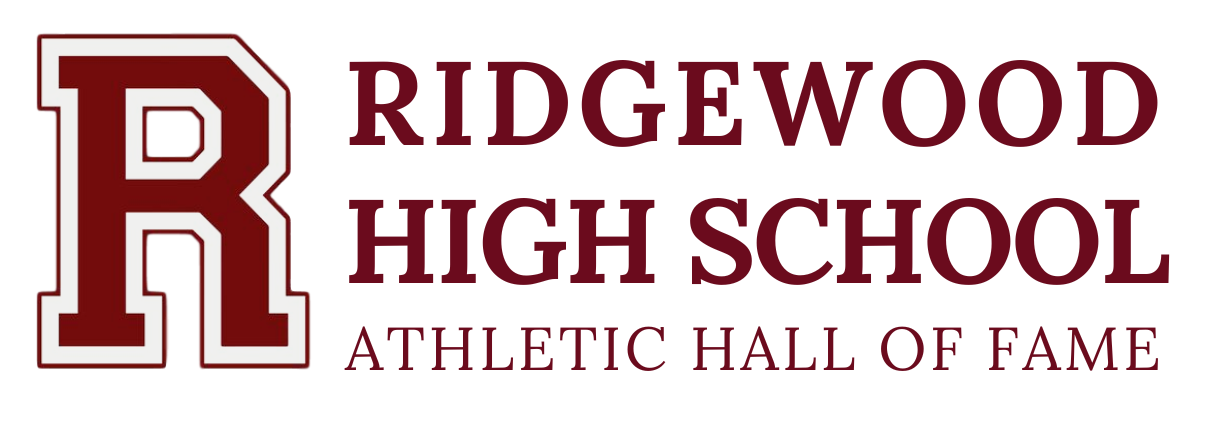Did You Know...?
1915 State of Athletic Participation in the Ridgewood Schools
The article is a report on the state of athletics and physical training n 1915. This article appeared in the “YEAR BOOK OF THE SCHOOLS from November , 1915.It was published by the Board of Education in Ridgewood , New Jersey to give a report on the state of the Ridgewood Public schools to Date. It recognizes the importance of participation in regular physical activity through a school-based curriculum in physical training and in organized programs of interscholastic athletics. This is the beginning of our tradition of excellence in providing a “sound mind in a sound body” as professed by the Greek Philosopher Thales and the Roman poet Juvenal. Today this same philosophy transcends our nationally recognized programs in health and wellness opportunities for all RHS students as well as one of the finest educationally based interscholastic athletic programs in the state, offering equal opportunities to both our male , female and non-binary student population. A true example of the rich blend of the academic with the physical for a well-balanced wholistic approach to education.
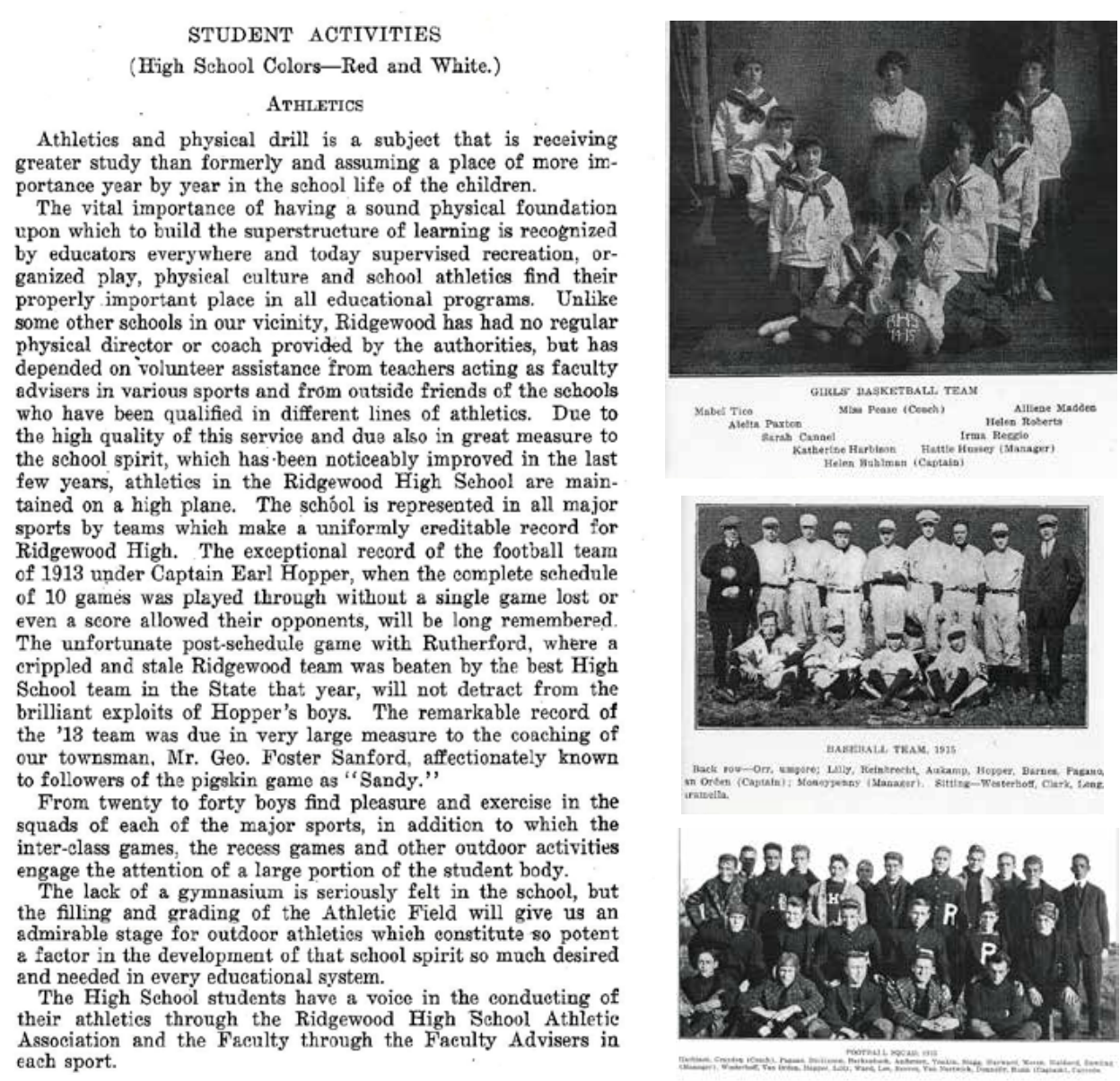
The First Varsity Soccer Team at RHS - 1927
Interscholastic soccer was approved as a minor sport by the RHSAA in 1922 and elevated to varsity status in the fall of 1927
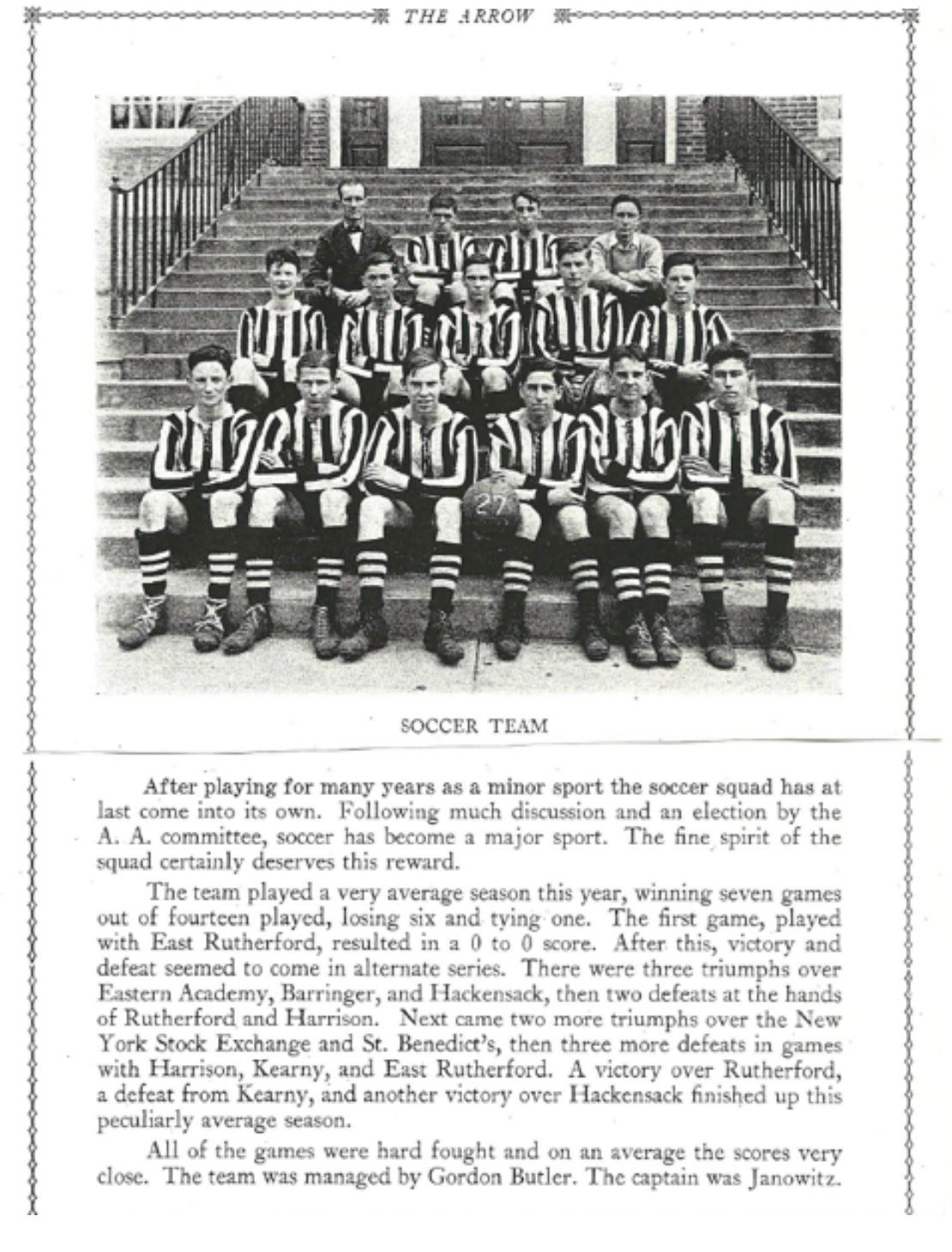
EVA SUYDAM, THE HEERMANCE PLACE PILLARS
As you approach Ridgewood High School on East Ridgewood Avenue, one cannot miss the iconic and beautiful campus of RHS. From the looming cupola that can be seen from many village vantage points to the looming façade in its grand architectural style the campus presents itself as an example of classical style that supports a tremendous “Tradition of Excellence. Part of the heritage of that tradition, lies in one of the most visible yet obscure recognitions of someone, many may consider, one of the primary founders of that tradition of excellence over one hundred years ago. So many RHS students and alumni have passed through the steadfast pillars at the East Ridgewood Avenue, Heermance Place entrance without, perhaps ever recognizing the significance and purpose of those pillars and who they represent.
Eva Suydam, the first woman teacher hired by the Ridgewood Public Schools in 1895, founder of the Arrow publication and the Dramatic Club (now known as RHS New Players Company), died at the early age of 44 after serving 27 years in the Ridgewood schools. Her influence, impact, and legacy are beautifully expressed by colleagues, students, and alumni in the February, 1923 edition of the Arrow: (https://maroonsonline.com/arrowyearbooks/1920s-arrow/1923-february-arrow/#page13).
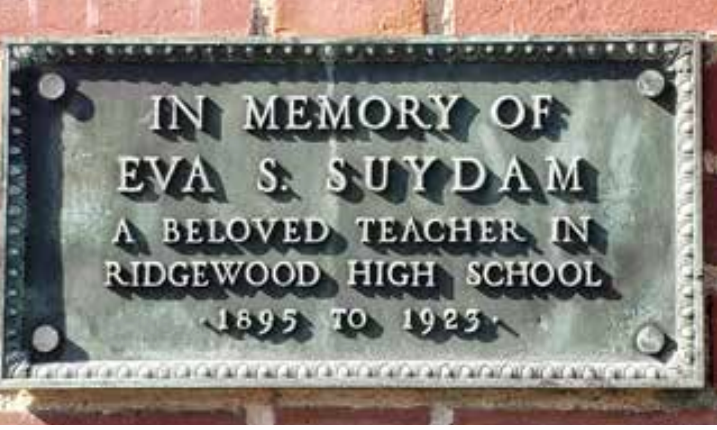
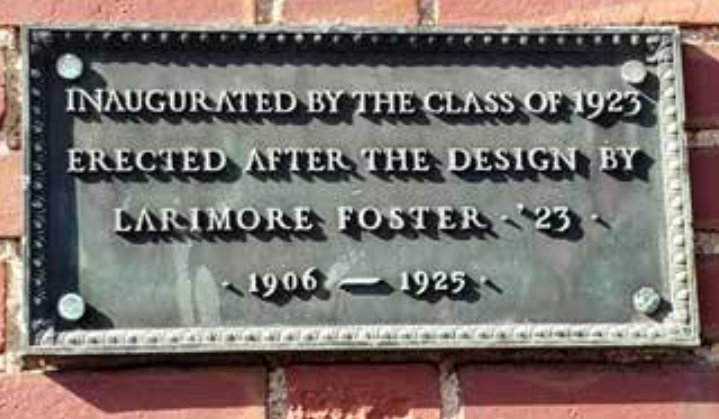

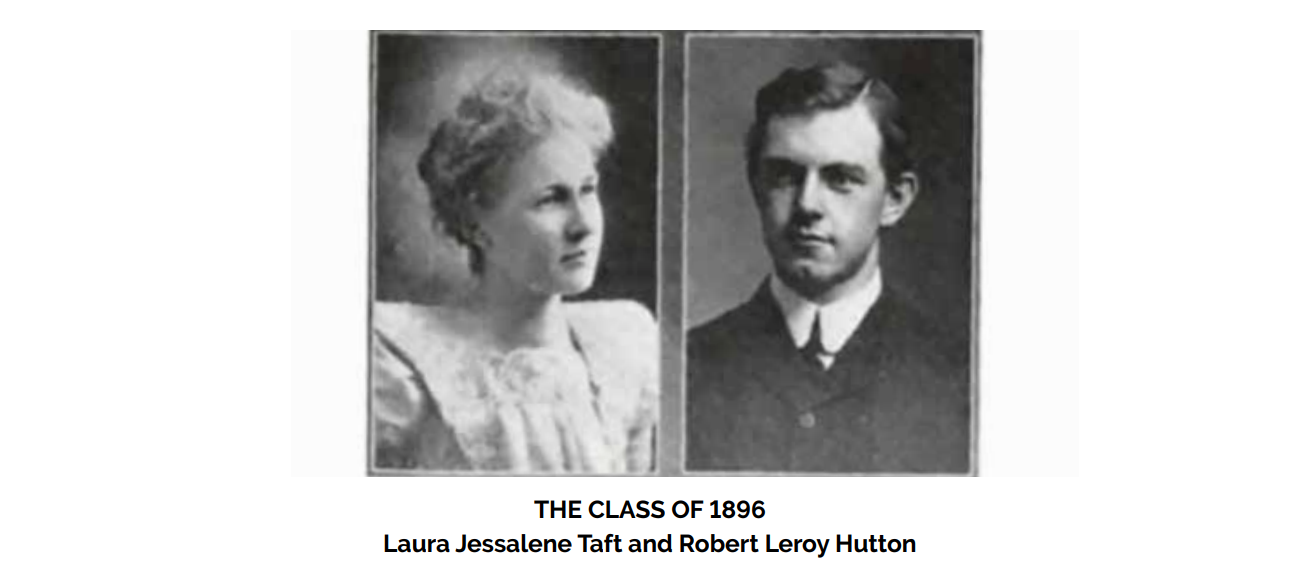
This beloved teacher was described as “sunny in temperament”, “unfailing in her goodness of heart”, and was known for her “delightfully mischievous sense of humor.” Of her, the students said, “She was always patient, always sympathetic; she always brought out the best there was in us.”
In a moving tribute, a fellow English teacher wrote: “She was able to recognize and catch on the wing small bits of happiness that sometimes escape us when we are demanding that the universe be remolded nearer to the heart’s desire.”
The Alumni Association hosted a reception for Miss Suydam in 1921 to honor her service to the Ridgewood High School. Upon her death, she was again honored with these words: “The members of the Alumni Association of the Ridgewood High School, as individuals and as a group,feel most keenly the loss of Miss Suydam, our highly respected and dearly loved friend. Everyone, almost without exception, who has come into personal contact with her, either through class work or club activity, and so realizes, and appreciates, how unstintingly she gave of herself, to her boys and girls.
Many of these boys and girls, now men and women, carried their friendship far beyond high school days, and always found in her an eager interest in their achievements and a spur to further efforts. The loss of this dear counselor will be felt, not only in Ridgewood, but in all corners of our country and countries abroad, wherever there lives a graduate of Ridgewood High School, still carrying with them the memory of her gentle kindness and quiet strength.” Ines C. Profumo, For the Alumni.
And in Ira Travell’s eulogy, he shared this sentiment: “...Miss Suydam was for a generation a pillar of strength to the Ridgewood High School... Her life constitutes an integral part of the history of the growth and development of the Ridgewood High School.” I.W. Travell, For the Board of Education.
Did You Know...?
The girls athletic club (GAC) at Ridgewood High School began around 1905. There was no gymnasium available at the Beech Street location, so the girls negotiated gym space at the White Star Athletic Clubhouse. They played their first basketball game on Dec 22, 1906. The team record for 1906-07 was 7-4. In 1907 the team joined the New Jersey Interscholastic League, which also had as members the Hackensack, Englewood, Passaic and Orange High Schools.
The Boys and Girls Athletic Associations at Ridgewood High School joined together in 1913 with a common organization, The Ridgewood Athletic Association (RAA), which promoted the facilitation of interscholastic men’s and women’s athletics at Ridgewood. Many of the local high schools had women’s sports that thrived in highly organized interscholastic leagues until the mid 1930’s when most of the women’s teams disappeared. It is theorized that, because of the great depression, athletics for women were cut for cost savings and replaced with periodic sport play days to fill the void.
The Boys Athletic Association (BAA) voted to add Football to its roster of athletic teams being sponsored for the first time in the fall of 1908. The team played 3 games that year. All of the games were played against the same competition, the Saginaw AC. The team record was 2 wins and 1 tie. It is recorded that RHS won their first ever football game 2-0, their second 5-0 and tied their third 5-5.
The BAA voted to drop Football for the 1909 season, but brought it back in 1910. By 1913, the football team at Ridgewood was regarded as one of the finest squads in Northern New Jersey and was referred to as the “Ridgewood Invincibles.” The team went on to great acclaim that season and gained great recognition again in 1915 when the team went undefeated.
Basketball for Boys and Girls remained the main focus for interscholastic competition during the 1909-10 school year.
On March 19, 1914 it was reported in the Ridgewood Herald that the Ridgewood High School Girls Basketball team defeated Montclair High School at Montclair by the score of 18-17 for their first victory ever versus the “Mounties.” Montclair had been the New Jersey state champion for three consecutive years prior to the RHS victory!
The first recorded reference to the RHS colors of “Maroon and White” were made in the winter issue of the 1910 Arrow (published seasonally) when describing the actions of the boy’s basketball team as the “Maroon and White.” The colors were officially declared in the written constitution of the Ridgewood High School Athletic Association (RAA), which was formed by the student body in 1913. The constitution was written sometime between 1913 and 1916. Article VIII Insignia Sec.1 states, “The colors of the Ridgewood High School are Maroon and White.” Section 2 goes on to explain, “The insignia of the Ridgewood High School are the letters R.H.S. maroon and white; the letter R. in white.”
Interestingly our tradition of giving a star for second, third, and now fourth year varsity letters was formulated in the original RAA constitution.
Section 4 under Article VIII states, “Only one letter shall be awarded to any student during the course for any one sport. For each additional year in which it services the requirements of the insignia as heretofore stated, shall be awarded a star.”
In 1911, a baseball team was formed for the first time since 1906. As stated in the Arrow 1911 spring quarterly, “For the first game the Ridgewood team were faultlessly attired in their new suits which were cut décolleté and up to date in every particular and so becoming! However, this fact did not help them on to victory for they met with a glorious defeat at the hands of the Ridgefield Park High School – which the score of 7-2 will show. This is not discouraging for with the able assistance of their new coach Dr. Whitney, and the enthusiasm the national game always inspires, and the necessary practice they expect to reach satisfactory results in games that are scheduled for the future.”
The first track meet was held at RHS June 6, 1913, which became an annual interclass (intramural) competition. There was a call to organize an interscholastic team for 1914. Records show that in the spring of 1914, a banner was won by RHS for defeating Paterson in a dual meet with each school having won a leg of a three meet competition, the next winner would be eligible to keep the banner.
A group of RHS athletes went to the Thirteenth Regimental Armory in Brooklyn on January 5, 1915 to compete for the Eastern Scholastic Championship. Practices were carried out through the winter months, “In order to prepare for this and various other track meets.” Further, “This practice will be for everybody because of the coming Interclass Meet and the Badge contest.”
The first recorded soccer match at RHS took place October 27, 1918 with the freshman class defeating the sophomore class 2-0. The junior and senior classes also played, but no record of a score has been found. The elementary schools competed in a highly organized interschool soccer league as far back as 1912 according to articles found in the Ridgewood Herald. They were divided into junior and senior levels of competition.
The Ridgewood Herald of December 17, 1914 reported that the Harrison Avenue School won the public school soccer championship at both the senior and junior levels. They were followed in the standings by the combined team (junior and senior level) of Beech Street and Union Street Schools, then Kenilworth School and Monore Street School. The Erie Avenue School did not participate because of low enrollment.
The March 19, 1914 edition of the Ridgewood Herald reported that money for the new soccer ball for the public school league was donated to principal Brooks by a “spirited citizen” who saw the principal on the way to the train station, noting he had heard of the need for a new ball. The citizen wanted to remain anonymous for his kind deed.
After many years playing as minor sport, soccer became a varsity sport in the fall of 1927. The sport was given major sport status after much discussion and an election by the RAA committee. As stated in the 1927 Arrow, “The fine spirit of the squad certainly deserves this reward.”
The first cross country meet at RHS was run on November 22, 1918. It was an interclass competition over a two and one half mile course with the finish on the new football field (now located at RHS) before the crowd that had gathered to watch the home gridiron battle with Marist High School.
In 1915, the students of RHS had an intense fund raising campaign to complete the refurbishing of the new athletic field at RHS, which is now the new field turf stadium. They surpassed their goal of raising $1,600, reaching nearly $1,700. The fund raising total was kept on a giant board resembling a thermometer in a location that is now Wilsey Square. The athletic field was purchased in 1913 and has been used ever since for Ridgewood High School Athletic contests. The first RHS team to use it was the football team for the 1913 season, even though RHS would not be open to students until May of 1919. It is clear at this time that the athletic field property, currently our high school stadium complex, was purchased as part of the property secured on East Ridgewood Avenue by the Board of Education in 1913 in hopes of constructing a new high school in the not too distant future. The property, not including the Stevens Field site, was purchased from Captain Edwards at a cost of $30,000.
Prior to the purchase of the athletic field location that is now on the west side of the high school, a large field was often used for athletics which was owned by the Masons and located approximately where the Masonic Temple is now, just off of South Maple Avenue. The Masons also owned a large field space across from the old golf club grounds, now present day Veterans Field, which was also used for sporting events. The old YMCA grounds were often used for athletic contests also.
It was reported in the October 16, 1913 Ridgewood Herald that a group of citizens wanted to organize a group to oversee the organization, supervision, administration of and development of the town’s (Ridgewood) inter school sports and games. This is a long ago predecessor of the “Sports Council” that we know of today that represents all of the youth sports activities in the village.
The 1913 group would be known as the “Athletic Advisory Council” and act in the same capacity as the organization in New York City that oversaw the administration of “The Public School Athletic League.” According to the records, a motion was made to the Ridgewood Board of Education for approval. It was approved and Dr. Craig would be the lead advisor of a committee that would include community members Frank Kyothe, Rev. Charles O. Wright, Philip L. Shuyler, Charles Woodworth and Mr. Lousing P. Wood, who would represent the local Home and School Association, the Parent Teacher Association and the Alumni of the Ridgewood Public Schools
